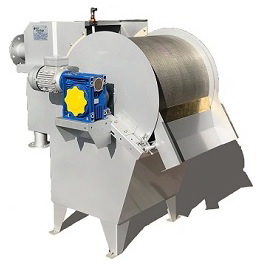The drum sieve is used at small and medium treatment plants and is intended for preliminary mechanical treatment of wastewater from various impurities. The drum screen is easy to operate and is ideal for pre-treatment of most industrial wastewater. Preliminary treatment of effluents from organic and inorganic solid suspensions is 30-60%, which significantly reduces the further load on treatment plants. The use of a drum sieve allows to remove from sewage the sand, large garbage, up to 30% of fats and other contaminants, which are characterized by indicators of BOD and COD.
The drum sieve is much smaller and has more power than other sieves used to separate suspensions and liquids. Compared to a static sieve of the same width, the filtration potential of the drum sieve is five times higher.
The drum sieve is equipped with an automatic self-cleaning system (rinsing with water), so it is practically not clogged.
For treatment, wastewater enters the receiving chamber through a pipe in the rear partof the case, and then evenly directed to the drum. The liquid passes through the apertures with a certain size into the inner part of the drum, and solid particles remain on the outer surface.
Advantages of a drum sieve:
- simple design and high reliability;
- compact size;
- The surface of the drum is made of wedge-shaped mesh and has excellent hydraulic characteristics.
Buy a drum sieve for sewage treatment plants
The drum sieve consists of the following elements:
- the mesh drum is made of stainless steel wrapped around a triangular frame with longitudinal ribs. The support of the triangular frame is attached to the inner surface of the drum. This element retains particles larger than the size of the drum apertures. This prevents the accumulation of sediment inside the sieve;
- the case of a sieve in which the drum is fixed on bearings. The rear part of the sieve has a receiving chamber in which wastewater is collected and distributed to the drum in a uniform stream;
- cleaning plate, which separates the accumulated sediment from the surface of the drum;
- drive that provides torque and consists of a gear motor connected directly to the drum shaft;
- receiving chamber of treated water;
- nozzles for rinsing the inner surface of the sieve with water under pressure.
Drum sieves are used in many industries:
- food, especially with a high content of oils in wastewater (dairy, fish, etc.);
- pulp and paper, to remove paper residues;
- wine, to remove branches and other impurities;
- production of plastics, to remove very small impurities (up to 0.125 mm).

